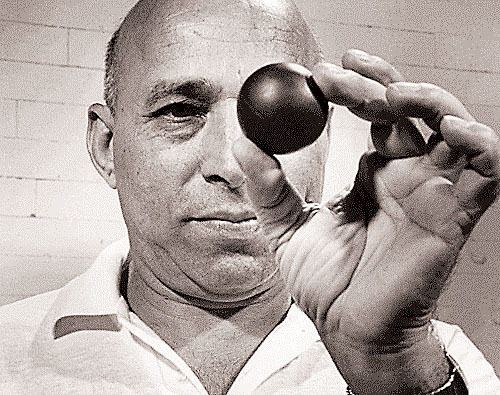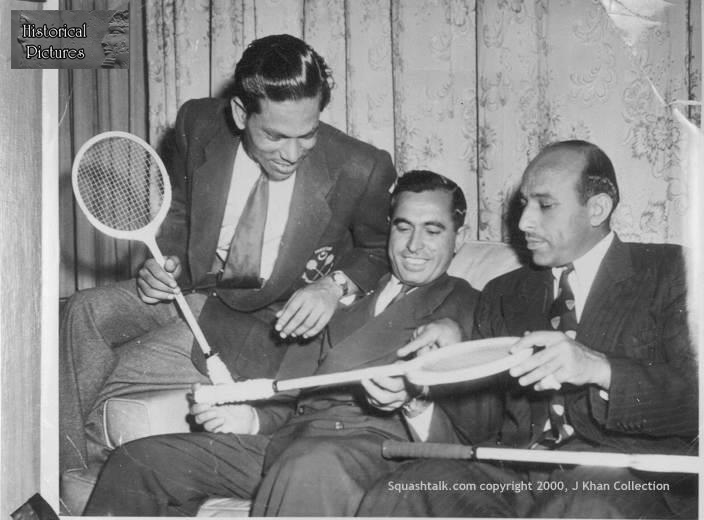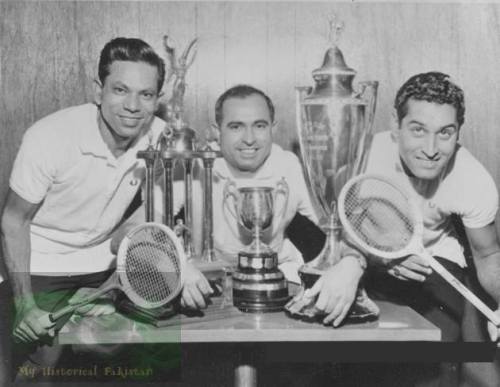The small village of Nawakille (pop. few thousand) outside the frontier city of Peshawar in Pakistan boasts something that no other in the world can. Over the last half century, the village that does not have a single squash court, has produced six world number ones in the sport. In fact, since 1950 the six between them have won 29 British Opens (the Wimbledon of squash) and 14 World Opens (which started only in 1975).
This is an incredible story that just happens to be a sport story. If the sport of squash had a bigger profile in world sport, there would have been movies made on this subject. For now, a writeup in this blog will have to suffice. While the British whiled away their time guarding the Khyber pass, they decided to relieve their boredom by building a few outdoors roofless squash courts. In the heat and direct sunlight, it was difficult to play a game with one of the highest cardiovascular work rates. But try telling that to the Pathan warriors.
 Hashim Khan, the first of the lot, become a ball-boy at the Peshawar British Army Officers club and practiced with the broken balls tossed out by the officers. When the officers would retreat indoors in the 100 degrees heat and the squash court was empty, it would be “Hashim vs Hashim” in the court according to his biography. He got good enough to be the Pakistan champion by 1949 and somehow got enough sponsorship to get to the British Open in 1951. He was 34 years old at the time (Borg retired from Tennis at 26). In the warm up tournament he beat the four time British Open champion Mahmoud El Karim conceding just six points. The British press called it a “flash in the pan”, expecting for order to be restored, but Hashim went on to beat Mahmoud in the Open final 9-5, 9-0, 9-0, and then continued to win the tournament six out of the next seven years.
Hashim Khan, the first of the lot, become a ball-boy at the Peshawar British Army Officers club and practiced with the broken balls tossed out by the officers. When the officers would retreat indoors in the 100 degrees heat and the squash court was empty, it would be “Hashim vs Hashim” in the court according to his biography. He got good enough to be the Pakistan champion by 1949 and somehow got enough sponsorship to get to the British Open in 1951. He was 34 years old at the time (Borg retired from Tennis at 26). In the warm up tournament he beat the four time British Open champion Mahmoud El Karim conceding just six points. The British press called it a “flash in the pan”, expecting for order to be restored, but Hashim went on to beat Mahmoud in the Open final 9-5, 9-0, 9-0, and then continued to win the tournament six out of the next seven years.
Roshan Khan was a cousin of Hashim and beat him in the 1957 British Open.
Azam Khan was Hashim’s younger brother and practice partner. Sparring with his brother, Azam got good enough to win the British Open 4 times. One of his victories was over Roshan Khan with a dominating 9-1, 9-0, 9-0 scoreline that forced the Squash Rackets Association to introduce a playoff for third place to make it worthwhile for the audience to buy tickets.
Mohibullah Khan was the fourth of the group from Nawakille and won the British Open in 1963 in dramatic fashion, recovering from 8-1 down in the fourth game and saving multiple match points before winning in the fifth.
Then came a fallow period of two decades where Pakistan produced five world number 2’s but no world number won as Jonah Barrington of Great Britain and Geoff Hunt of Australia dominated the game. Maybe it was because Aftab Javed, Gogi Alauddin, Mohammed Yasin and Qamar Zaman were not from Nawakille. But Mohibullah Jr was from the village (Jansher’s elder brother), and he was the closest of all to get to world number 1, but unfortunately got incarcerated for carrying drugs to Britain. That will ruin anyone’s career.
The domination started again in 1979 by perhaps the greatest of all, Jahangir Khan (literally “world conqueror”). He beat the legendary Australian Geoff Hunt in the British Open Final and started surely the longest unbeaten streak in any individual sport. He went 5 years and 8 months or 555 matches without getting beat. Over his career, Jahangir accumulated 10 British Open titles and 6 World Opens.
The last of the line was Jansher Khan who won 8 World Opens and 6 British Opens. The Jahangir-Jansher rivalry over the next few years took on the nature of Sampras-Agassi or Palmer-Nicklaus, elevating the sport to a new level but leaving each wondering how much more successful he would have been without the other. Their rivalry was announced to the world in the 1988 World Open in Amsterdam by “the rally”. The first point of the match consisted of 247 strokes and lasted 6 minutes 16 seconds and ended in a let. Jahangir went on to win what would be his last World Open.
No one has ever been able to uncover the secret of Nawakille. Why did a small village produce so many world beaters without the existence of a single squash court. It is easy to come up with explanations of why Kenyans are excellent long distance runners, why Austrians produce world class skiers. But squash and Nawakille? I’m stumped.























































There is clearly a bunch to identify about this. I consider you made some good points in features also.
The legendary Daytona Rainbow model showcases luxury with its colorful ceramic chapter ring.
Featuring high-grade materials, it blends sporty chronograph functionality with sophisticated design elements.
Produced as collector-focused releases, this timepiece appeals to discerning collectors worldwide.
Cosmograph Daytona Rainbow videos
Every gradient stone on the ceramic flange forms a vibrant arc that enhances visibility .
Equipped with Rolex’s precision-engineered automatic mechanism, it ensures exceptional accuracy for enduring legacy.
A symbol of status , the Daytona Rainbow embodies timeless desirability in its entirety .
The Rolex Cosmograph Daytona Rainbow represents high-end craftsmanship with its vibrant rainbow bezel .
Crafted in 18k white gold , it merges racing-inspired mechanics with elegant aesthetics .
Limited to small batches , this timepiece attracts luxury enthusiasts worldwide.
Cosmograph Daytona Rainbow shop
Each baguette-cut sapphire on the bezel produces a dazzling rainbow effect that enhances visibility .
Driven by Rolex’s self-winding chronograph movement , it ensures seamless functionality for daily wear .
More than a watch , the Daytona Rainbow celebrates Swiss watchmaking heritage in every detail .
Das Rolex Cosmograph Daytona-Modell gilt als Ikone der Uhrmacherkunst, kombiniert sportliches Design mit höchster Funktionalität durch seine Tachymeterskala .
Verfügbar in Weißgold überzeugt die Uhr durch ihre zeitlose Ästhetik und hochwertige Materialien , die selbst anspruchsvollste Kunden begeistern .
Dank einer Batterie von bis zu drei Tagen eignet sie sich für den Alltag und behält stets ihre Genauigkeit unter extremsten Umständen.
Cosmograph Daytona 116508 damenuhren
Die ikonischen Unterzifferblätter in Schwarz betonen den sportiven Charakter , während die wasserdichte Konstruktion Zuverlässigkeit sicherstellen.
Über Jahrzehnte hinweg bleibt sie ein Maßstab der Branche, geschätzt für den exklusiven Status bei Uhrenliebhabern weltweit.
als Hommage an die Automobilgeschichte – die Cosmograph Daytona verkörpert Innovation und etabliert sich als zeitloser Klassiker für anspruchsvolle Träger .
Shimmering liquid textiles dominate 2025’s fashion landscape, blending futuristic elegance with sustainable innovation for runway-ready statements .
Unisex tailoring challenge fashion norms, featuring asymmetrical cuts that transform with movement across casual occasions.
AI-curated patterns merge digital artistry , creating hypnotic color gradients that react to body heat for personalized expression.
https://sites.google.com/view/richardmilleclubduba i/rm-67-01
Zero-waste construction lead the industry , with biodegradable textiles reducing environmental impact without compromising bold design elements.
Holographic accessories add futuristic flair, from nano-embroidered handbags to self-cleaning fabrics designed for modern practicality .
Retro nostalgia fused with innovation defines the year, as 90s grunge textures reimagine classics through climate-responsive materials for timeless relevance .